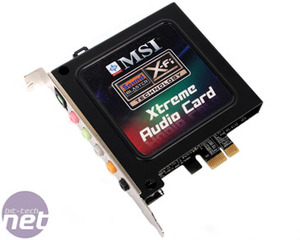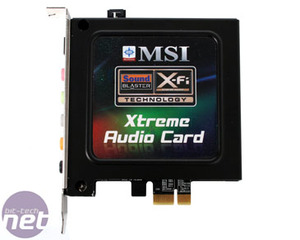Board Layout Continued
MSI employs the same DrMOS power phases it used on its P45 boards - these are an all-in-one MOSFET pair plus driver IC that saves board space and is generally a bit easier to cool. MSI has avoided the numbers game once again and only includes six phases for CPU socket, as well as a expanding it further 2+2 for the CPU Uncore section (that includes L3 cache, memory controller and QPI) and X58 northbridge.This is great - the DrMOS chips are neat little devices and, combined with MSI's GreenPower, they've always worked well for us. The memory gets a pair of phases as well, but this uses normal Power-PAK MOSFETs instead. In addition to these, there are six quite large environmentally sealed ferrite chokes for the CPU DrMOS, then four smaller ones for the rest.
MSI uses quality Nippon-Chemicon solid aluminium capped capacitors over the entire board, in addition to high density Hi-C (Highly Conductive Polymerised) capacitors that are usually found on workstation and server class boards, and occasionally some older Asus Republic of Gamer boards too (the first Striker, for example).
The MSI board includes a huge ten SATA ports and is also one of the first boards to drop the floppy connector. Four of those SATA are spurred from a single PCI-Express x1 lane through the JMicron JMB363 which offers two ports, then these are split into four using two more JMicron JMB322s: talk about bandwidth constriction! It's not the best setup as we found out in the hard drive test, and even though it supports four ports it eschews RAID 5 for just 0, 1 and JBOD. Still, we can't sniff at the choice available and between ten SATA and two eSATA, with the potential for converting two more SATA to eSATA, there's a ton of expansion here.
Further features include a pair of PCI-Express Gigabit Ethernet connectors that include the usual teaming function, but there's absolutely no on-board audio. Instead MSI has saved the PCB space and included a Creative X-FI Xtreme Audio card that handles the bundled audio function, and if you don't fancy letting Creative loose on your system it frees up a PCI-Express slot for something else. Unlike the Asus P6T Deluxe, the upper-most x1 slot doesn't have the northbridge heatsink interfering with long expansion cards.
With regards to cooling, MSI has split its power regulation cooling from the X58 and ICH10R and attempted to market this off as an advantage under its Xpress Cool section. We believe it's a mistake though, for several reasons: firstly, the northbridge idles at 60'C! While it successfully survived our stress test without additional airflow, in a hot case environment and overvolted we'd be sceptical about what it can take. There's no additional option for a fan, no easy way to get a fan between the CPU socket and graphics card (not to mention the heat coming off both!) and no easy way to change it for something else since it's irrevocably tied to the southbridge.
On the other side, the DrMOS heatsink is flimsy and is prone to easily being pushed back and forth, potentially corrupting its cooling ability. Finally there's not a single screw in sight: push-pins don't cut it on high end boards, in our opinion. Sure, the production line manager might complain, but we've seen those very capable Chinese ladies on the Kunshan production line put all sorts of electrical hardware (notebooks) together, so using a few screws instead of push pins can't hurt on a motherboard costing the wrong side of £250.
X-Fi Xtreme Audio
There's no audio on the actual motherboard, instead MSI also includes a PCI-Express X-Fi Xtreme Audio card instead. It's exactly the same as previous Diamond boards have included, however this time has a metal covering over it as well. Because it uses a standard PCI-Express x1 slot it'll actually work in any motherboard, not just MSI, and here on its "Gaming" board we could argue it's particularly suited offering EAX support (Alchemy in Vista) and basic X-Fi features. They're all software driven features, but you could say the same about every onboard audio on the market. It's a good niche and nice "freebie" but we do miss Dolby and/or DTS capabilities though.Naturally we'd test it to compare against the other solutions we've seen, but we found we were unable to RightMark test it at all, so we are unable to give a comparative opinion unfortunately.

MSI MPG Velox 100R Chassis Review
October 14 2021 | 15:04













Want to comment? Please log in.